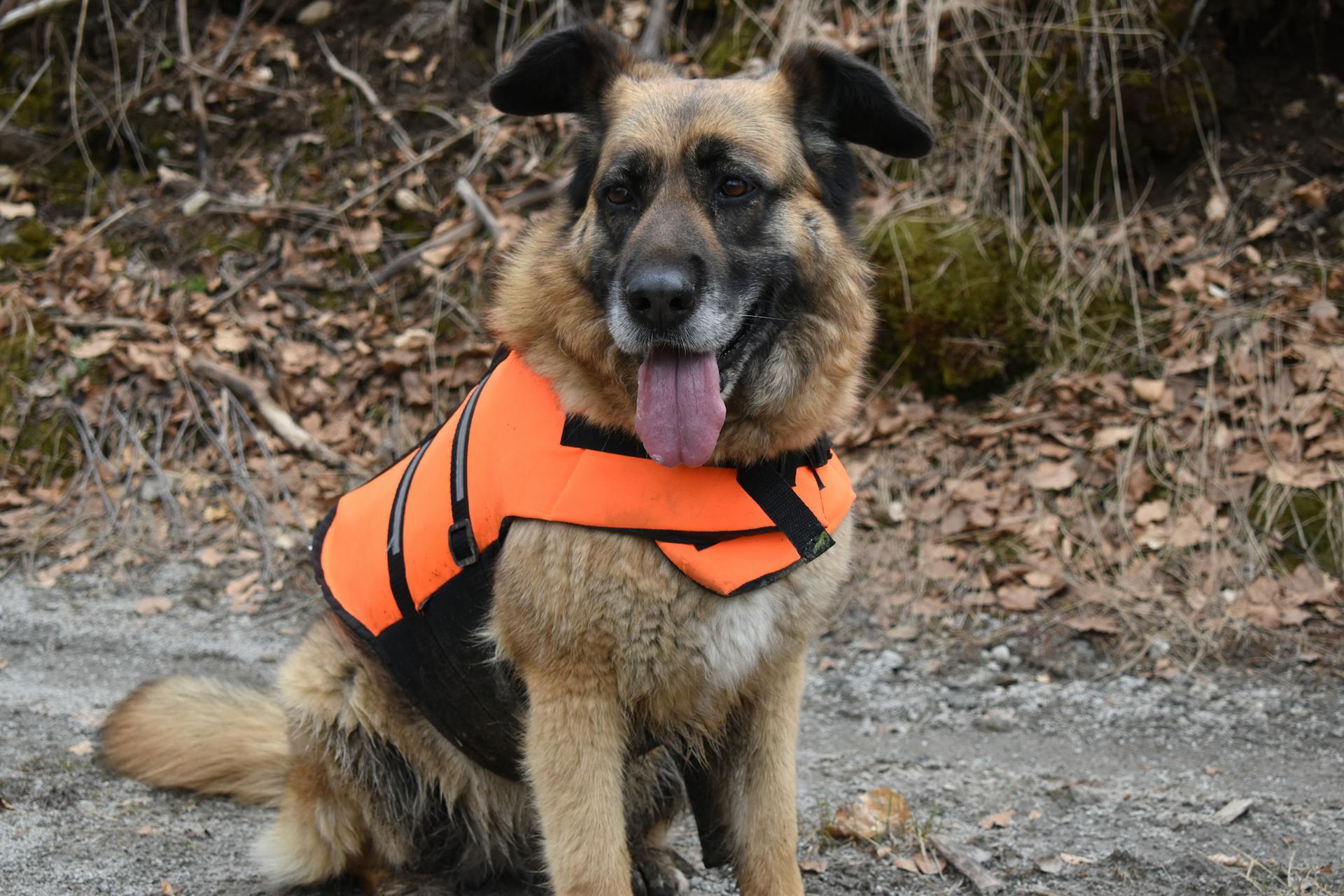
The Neapolitan Mastiff is an ancient breed with a rich history that dates back thousands of years. They originated in the Campania region of Italy, specifically in the city of Naples.
These massive dogs were initially bred as guard dogs and companions for the noble families of the time. Their size, strength, and loyalty made them the perfect watchdogs.
In ancient Rome, the Neapolitan Mastiff was known as the "Mastino Napoletano" and was highly valued for its protective instincts. They were often depicted in art and literature as symbols of power and loyalty.
Their distinctive appearance, with a short, easy-to-maintain coat and a wrinkled face, has remained largely unchanged over the centuries.
Neapolitan Mastiff History
The Neapolitan Mastiff has a rich history dating back to 3000 B.C. They originated in Italy, particularly around the region of Naples, and have been a symbol of strength and loyalty for centuries.
Their ancestors were used in Roman arenas, showcasing their prowess against fierce adversaries. The breed's intimidating presence and formidable strength made them ideal for such missions, but they were also valued as companions, offering protection and companionship to soldiers and people of high society.
Take a look at this: English Mastiff Bite Psi
The Neapolitan Mastiff was developed from the Molossus war dog of antiquity, and evidence of their ancestry dates back to 3000 B.C. They were crossed with shorthaired dogs from India by Alexander the Great, and later became a favorite among the Romans.
The breed was nearly extinct after World War II, but a group of dedicated Italian breeders, led by Piero Scanziani, set out to revive the breed. They standardized both its appearance and temperament, and the breed was officially recognized by the Ente Nazionale della Cinofilia Italiana (ENCI) in 1949.
Here are some key dates in the Neapolitan Mastiff's history:
- 3000 B.C.: Evidence of the breed's ancestry dates back to this time.
- 330 B.C.: Alexander the Great crossed giant war dogs from Macedonia with shorthaired dogs from India.
- 1949: The Ente Nazionale della Cinofilia Italiana (ENCI) recognized the breed.
- 2004: The American Kennel Club (AKC) recognized the breed.
Physical Characteristics
The Neapolitan Mastiff's physical characteristics are truly impressive. Their coat is short, dense, and smooth, lying close to the body and providing protection against the elements.
The breed's coat texture is uniform all over the body, requiring minimal grooming and enhancing their dignified appearance. The coat is no more than one inch in length and doesn't have any fringe, making it easy to maintain.
One key feature of the Neapolitan Mastiff's coat is the brindle markings, which are represented by the genetic code "ee". This unique marking adds to the breed's distinctive appearance.
In terms of proportion and substance, the Neapolitan Mastiff has a robust and muscular build, with a body length that is typically 10 to 15 percent greater than the height at the withers. This gives them a slightly rectangular profile and a substantial frame.
The breed's large, well-rounded bones contribute to their overall impression of strength and power, and their substantial body mass is well distributed, providing balance and a harmonious balance between power and functionality.
Proportion & Substance
The Neapolitan Mastiff's robust build is a key part of its general appearance. This breed's substantial frame is evident in its large, well-rounded bones.
The body length of a Neapolitan Mastiff is typically 10 to 15 percent greater than its height at the withers, giving it a slightly rectangular profile.
A Neapolitan Mastiff's substantial body mass is well distributed, providing balance and contributing to its impressive physical presence. This balance allows the breed to move with fluidity and effortlessness.
The breed's overall substance should never compromise its agility or endurance, illustrating a harmonious balance between power and functionality.
Coat Characteristics
The Neapolitan Mastiff's coat is quite impressive, and it's not just for show. The coat is short, dense, and smooth, lying close to the body and being no more than one inch in length.
This unique texture serves a practical purpose, providing protection against the elements and resistance from minor abrasions. The coat is also very easy to maintain, requiring minimal grooming.
One notable aspect of the coat is its uniformity all over the body, which enhances the breed's dignified appearance.
Tail
The Neapolitan Mastiff's tail is a distinctive breed feature that should never be docked.
It is set on slightly lower than the topline, emerging as a natural continuation of the spine.
The tail is thick at the base and tapers towards the tip, carried either straight or slightly curved in a "S" shape.
When the dog is relaxed, the tail hangs down, but when the dog is active, the tail is raised to the horizontal or a little higher than the back.
The tail should not have any kinks and should not be less than one-third the length from the point of its insertion to the hock joint.
It should never be carried upward or curved over the back.
Additional reading: Pomeranian Dog Origin
Classification and Standards
The Neapolitan Mastiff is a breed that's recognized worldwide, and it's categorized into a specific Group based on its unique characteristics. This Group classification is a key part of what makes the breed so beloved by many dog owners.
The Neapolitan Mastiff is recognized by several leading registries and kennel organizations, including the American Kennel Club, United Kennel Club, Canadian Kennel Club, Australian National Kennel Council, The Royal Kennel Club, and Fédération Cynologique Internationale.
Each of these organizations has its own breed standard for the Neapolitan Mastiff, which outlines the breed's characteristics and traits. Here are some of the breed standards from around the world:
If you're interested in learning more about the Neapolitan Mastiff and determining if your dog is a part of this breed, you can check out Wisdom Panel's DNA tests.
Frequently Asked Questions
What breeds make a Neapolitan Mastiff?
The Neapolitan Mastiff is believed to have originated from the cross between giant war dogs and short-haired Indian dogs, with Alexander the Great's influence in the 4th century BC. Its ancestry is a unique blend of ancient breeds.
What was the original purpose of the mastiff?
Originally, Mastiffs were bred as guard dogs to protect homes and property.
Are Neapolitan mastiffs rare?
Yes, Neapolitan mastiffs are relatively rare, with the breed only gaining official recognition by the American Kennel Club in 2004. Their unique characteristics and needs make them a less common sight.
How was the Neapolitan Mastiff created?
The Neapolitan Mastiff was created by crossing giant war dogs from Macedonia with shorthaired dogs from India, a process that began around 330 B.C. This ancient breeding program laid the foundation for one of the world's most iconic and powerful breeds.
Is a Neapolitan Mastiff Italian?
Yes, the Neapolitan Mastiff is an Italian breed, also known as an "Italian Mastiff" or "Mastino." Originating in Italy, they are a proud symbol of the country's rich canine heritage.
Sources
- https://retrieverman.wordpress.com/2012/04/16/the-original-function-of-neapolitan-mastiffs/
- https://www.akc.org/dog-breeds/neapolitan-mastiff/
- https://www.wisdompanel.com/en-us/dog-breeds/neapolitan-mastiff
- https://showsightmagazine.com/dog-breeds/neapolitan-mastiff/
- https://www.dailypaws.com/dogs-puppies/dog-breeds/neapolitan-mastiff
Featured Images: pexels.com


